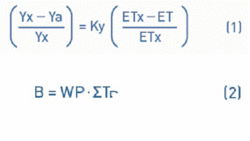Schéma de calcul

AquaCrop simulates final crop yield in four steps (which run in series in each daily time increment), as described below. The four steps are easy to understand, thereby ensuring transparency in the modelling approach.
- Development of green canopy cover: in AquaCrop, foliage development is expressed through green canopy cover (CC) rather than leaf area index. CC is the fraction of the soil surface covered by the canopy; it ranges from zero at sowing (i.e. 0 percent of the soil surface covered by the canopy) to a maximum value at mid-season as high as 1 if full canopy cover is reached (i.e. 100 percent of the soil surface is covered by the canopy). By adjusting the water content in the soil profile each day, AquaCrop keeps track of stresses that might develop in the root zone. Soil-water stress can affect the leaf and therefore canopy expansion; if severe it can trigger early canopy senescence.
- Crop transpiration: in well-watered conditions, crop transpiration (Tr) is calculated by multiplying the reference evapotranspiration (ETo) with a crop coefficient (KcTr). The crop coefficient is proportional to CC and hence varies throughout the life cycle of a crop in accordance with the simulated canopy cover. Not only can water stress affect canopy development, it can also induce stomata closure and thereby directly affect crop transpiration.
- Above-ground biomass: the quantity of above-ground biomass (B) produced is proportional to the cumulative amount of crop transpiration (ΣTr); the proportional factor is known as biomass water productivity (WP). In AquaCrop, WP is normalized for the effect of climatic conditions, making normalized biomass water productivity (WP*) valid for diverse locations, seasons and concentrations of carbon dioxide.
- Crop yield: the simulated above-ground biomass integrates all photosynthetic products assimilated by a crop during the season. Crop yield (Y) is obtained from B by using a harvest index (HI) – which is the fraction of B that is harvestable product. The actual HI is obtained during simulation by adjusting the reference harvest index (HIo) with an adjustment factor for stress effects.
